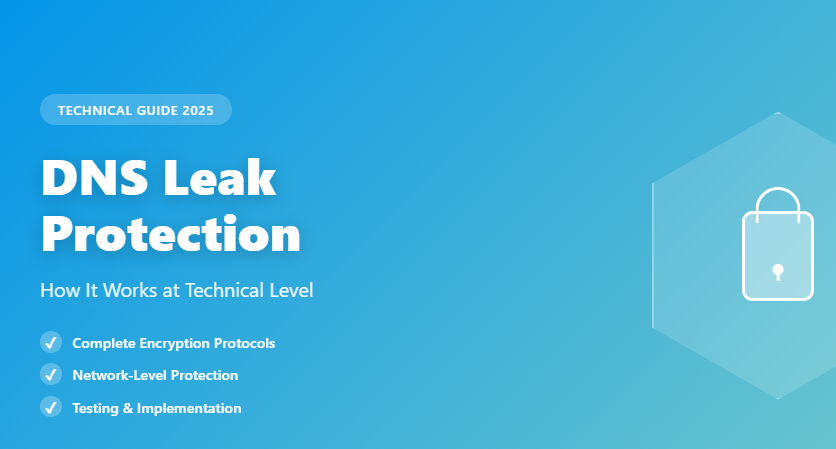DNS Leak Protection – How It Works at Technical Level

According to industry reports from 2024, the global VPN market reached approximately $44.6 billion, yet many users remain unaware that their DNS requests may be leaking outside their encrypted VPN tunnel. When you connect to a VPN, you expect complete privacy protection. However, DNS leaks occur when requests are sent to an ISP’s DNS servers even when a VPN is being used. DNS leak protection ensures your domain name queries stay within your VPN’s encrypted tunnel, preventing your internet service provider from monitoring your browsing activity. Understanding the technical mechanisms behind this protection is essential for maintaining true online anonymity.
What Is DNS Leak Protection and Why It Matters
DNS leak protection is a security feature that forces all domain name system queries through your VPN’s encrypted tunnel rather than allowing them to bypass to your ISP’s DNS servers. This technology operates at the network level to intercept and redirect DNS traffic.
Understanding the DNS Resolution Process
The Domain Name System translates human-readable website addresses into IP addresses that computers use to locate servers. DNS is like the phonebook of the internet, translating easy-to-understand website names into IP addresses that devices use to locate each other.
Without DNS leak protection, this translation process can expose your browsing activity:
- Your device sends a DNS query to resolve a domain name
- The query bypasses your VPN tunnel and reaches your ISP’s DNS server
- Your ISP logs which websites you’re visiting
- Your real IP address and location become visible
The Security Gap in Standard VPN Connections
An improperly configured VPN is most likely to result in a DNS leak when it assigns a DNS server belonging to the user’s ISP. This configuration flaw creates a critical privacy vulnerability that negates the security benefits of using a VPN.
The technical challenge stems from how operating systems handle DNS resolution. Your system maintains default DNS server settings that can override VPN configurations under certain conditions.
Technical Architecture of DNS Leak Protection
DNS leak protection implements several technical layers to ensure complete query containment within the VPN tunnel. Understanding these mechanisms reveals how robust protection actually works.
DNS Request Interception and Routing
Modern DNS leak protection operates through network-level interception. When your device initiates a DNS query, the protection system:
- Intercepts the request at the network stack level
- Validates the destination DNS server
- Blocks unauthorized DNS destinations
- Routes the query through the VPN tunnel
- Delivers the request to the VPN provider’s DNS servers
This process happens transparently, with no user intervention required once properly configured.
Encrypted DNS Protocol Implementation
The Cybersecurity and Infrastructure Security Agency published encrypted DNS implementation guidance in May 2024 to help organizations encrypt DNS traffic. Modern DNS leak protection incorporates these encryption protocols.
DNS-over-HTTPS (DoH) wraps DNS queries in HTTPS encryption, making them indistinguishable from regular web traffic. This prevents network observers from identifying DNS requests or reading their contents.
DNS-over-TLS (DoT) creates a dedicated encrypted channel for DNS queries using Transport Layer Security. This protocol provides strong encryption while maintaining clear separation between DNS and other traffic.
For more details on encryption standards, read our analysis of VPN encryption protocols and security features.
Firewall Rules and DNS Blocking
Technical implementation includes firewall-level blocking of unauthorized DNS traffic. These rules operate at the packet level to prevent any DNS queries from reaching non-approved destinations.
The firewall configuration typically includes:
- Block all outbound traffic to port 53 (standard DNS) except through VPN
- Block DNS-over-HTTPS to third-party resolvers
- Prevent IPv6 DNS leaks when IPv6 isn’t supported
- Monitor and log blocked DNS attempts
Common Causes of DNS Leaks
Understanding why DNS leaks occur helps in implementing effective protection strategies. Several technical factors contribute to DNS leak vulnerabilities.
Windows Smart Multi-Homed Name Resolution
Starting with Windows 8, Microsoft introduced “Smart Multi-Homed Named Resolution” which altered how Windows handled DNS requests, ensuring a DNS request could travel across all available network interfaces. This feature creates DNS leaks by sending queries to multiple DNS servers simultaneously.
The Windows SMHNR system prioritizes speed over security. When you connect to a VPN, Windows may still send DNS queries to your ISP’s servers alongside queries sent through the VPN tunnel.
Transparent DNS Proxying by ISPs
Some ISPs have started forcing customers to use their DNS servers even when they change their settings to a third-party VPN, using a transparent proxy that forces a DNS leak by redirecting web activity to its own DNS servers.
This technique intercepts DNS traffic at the network infrastructure level, making it particularly difficult to detect and prevent without proper DNS leak protection.
IPv6 Compatibility Issues
IP addresses were originally 32-bit IPv4 addresses, but 128-bit IPv6 addresses have been created to extend the pool of IP addresses, and some VPNs may not support IPv6, which may push a user’s DNS request outside of the encrypted tunnel.
When your VPN only supports IPv4 but your device and network use IPv6, DNS queries can leak through the unprotected IPv6 connection.
Manual Network Configuration Changes
Software updates or system changes can reset DNS configurations to default settings, creating unexpected leaks. This happens because:
- Operating system updates overwrite custom DNS settings
- Network adapter drivers reset to default configurations
- VPN client updates may not preserve custom settings
- Manual troubleshooting changes persist after VPN disconnection
How to Test for DNS Leaks
Testing for DNS leaks should be part of regular security maintenance. Several technical methods reveal whether your DNS queries are properly protected.
Online DNS Leak Testing Tools
A DNS leak test will show if your internet traffic is being routed through your chosen DNS. These tools work by having your browser resolve unique domain names created specifically for testing.
The test process operates as follows:
- Connect to your VPN service
- Visit a DNS leak test website
- The site generates unique test domains
- Your browser attempts to resolve these domains
- The test server logs which DNS servers received the queries
- Results display the DNS server details
If test results show your ISP’s DNS servers or unexpected third-party resolvers, you have a DNS leak.
Standard vs Extended DNS Testing
Standard test performs 1 round of 6 queries for a total of 6 queries, which should be sufficient to discover if you have a DNS leak, while extended test performs 6 rounds of 6 queries for a total of 36 queries.
Extended testing provides more comprehensive results by:
- Querying multiple DNS servers over time
- Detecting intermittent leaks that standard tests miss
- Revealing backup DNS servers that might be leaking
- Testing under various network load conditions
For additional security verification, learn about methods to stop your VPN from leaking IP addresses.
Analyzing DNS Leak Test Results
Understanding test results requires examining specific data points:
DNS Server IP Addresses – Should belong to your VPN provider, not your ISP
Geographic Location – Should match your VPN server location
Organization Name – Should show your VPN company or their DNS provider
Consistency – All queries should resolve through the same DNS infrastructure
DNS Leak Protection Implementation Methods
Implementing DNS leak protection requires technical configuration at multiple system levels. Different approaches offer varying degrees of security and complexity.

VPN Client Built-In Protection
The simplest way is through VPN clients that include DNS leak protection, though only a few VPN providers supply this option. Modern VPN applications handle DNS leak protection automatically through:
- Forced DNS server assignment during connection
- Network routing table modifications
- Firewall rule implementation
- Monitoring of DNS query destinations
Quality VPN services configure these protections without requiring manual intervention, making them accessible to non-technical users.
Manual DNS Configuration
Advanced users can manually configure DNS leak protection at the system level. This involves:
Router-Level Configuration – Set VPN provider’s DNS servers as the only allowed DNS resolvers. This ensures all devices on your network use protected DNS.
Network Adapter Settings – Manually specify DNS servers in network connection properties. Remove automatic DNS detection to prevent ISP server usage.
Hosts File Modifications – Create local DNS overrides for frequently accessed domains, though this approach is limited and impractical for comprehensive protection.
Operating System-Specific Solutions
Different operating systems require tailored approaches to DNS leak protection:
Windows – Disable SMHNR through registry modifications. Configure network adapter priority to ensure VPN adapter processes DNS queries first.
macOS – Use DNS configuration profiles to lock DNS settings. Implement firewall rules through pf (packet filter) to block unauthorized DNS traffic.
Linux – Configure resolv.conf with VPN DNS servers. Use iptables rules to drop packets destined for non-VPN DNS servers.
Mobile Platforms – Enable always-on VPN settings. Configure private DNS settings to use encrypted DNS providers.
Advanced DNS Leak Prevention Techniques
Beyond basic protection, advanced techniques provide additional security layers for high-risk environments or users with elevated privacy requirements.
Kill Switch Integration
Kill switch functionality complements DNS leak protection by severing all internet connectivity if the VPN connection drops unexpectedly. This prevents DNS queries from leaking during connection failures.
The technical implementation monitors VPN connection status and:
- Detects VPN disconnection events
- Immediately blocks all network traffic
- Prevents DNS queries from reaching ISP servers
- Restores connectivity only after VPN reconnection
Understanding how government agencies track VPN users highlights why kill switches are critical for comprehensive protection.
DNS-over-HTTPS and DNS-over-TLS
CISA’s encrypted DNS implementation guidance from April 2024 requires agencies to encrypt DNS traffic wherever technically supported. These protocols provide defense-in-depth:
DoH Benefits:
- Encrypts DNS queries within HTTPS traffic
- Prevents deep packet inspection from identifying DNS requests
- Works seamlessly with existing HTTPS infrastructure
- Bypasses network-level DNS blocking
DoT Benefits:
- Dedicated encryption for DNS traffic
- Easier to identify and manage DNS traffic separately
- Lower overhead than DoH in some implementations
- Better performance for high-volume DNS resolution
VPN Provider DNS Infrastructure
Leading VPN services operate their own DNS server infrastructure to maintain complete control over the DNS resolution process. This approach offers:
- No third-party logging of DNS queries
- Reduced latency through geographically distributed servers
- Custom security features like malware domain blocking
- Complete alignment with VPN provider’s privacy policy
NordVPN prevents DNS leaks by only using company-operated DNS servers and sending all DNS queries over an encrypted tunnel, resolving them on the same VPN server you’re connected to.
Multi-Hop VPN Configurations
Multi-hop or cascading VPN connections route traffic through multiple VPN servers in sequence. This technique provides additional DNS leak protection by:
- Separating DNS resolution from exit server
- Creating multiple encryption layers
- Distributing trust across different server locations
- Making DNS query tracing significantly more difficult
DNS Leak Protection and Zero Trust Architecture
The Federal Zero Trust Strategy requires agencies to encrypt all DNS traffic as part of zero trust implementation. Modern security frameworks recognize DNS protection as foundational to zero trust principles.
Zero Trust DNS Principles
Zero trust architecture applies “never trust, always verify” to DNS traffic:
- Assume all network paths are hostile
- Encrypt all DNS queries regardless of network
- Verify DNS query destinations continuously
- Log all DNS activity for analysis
- Implement least-privilege access to DNS resources
Enterprise DNS Leak Protection
CISA’s Protective DNS service provides device-centric protection for organizational networks and standalone devices regardless of network location, supporting both traditional unencrypted DNS and modern encrypted DNS protocols.
Organizations implementing DNS leak protection at scale must address:
Centralized DNS Management – Deploy organization-wide DNS policies that enforce encrypted DNS usage across all endpoints.
Roaming Device Protection – Ensure remote and mobile workers maintain DNS leak protection when connecting from untrusted networks.
Cloud Integration – Extend DNS leak protection to cloud-hosted resources and services.
Compliance Monitoring – Implement continuous monitoring to verify DNS leak protection remains effective across the organization.
DNS Leak Protection Performance Considerations
While DNS leak protection is essential for security, it introduces technical considerations that affect network performance and user experience.
Latency and Resolution Speed
DNS leak protection can impact resolution times through:
- Additional encryption/decryption overhead
- Routing queries through VPN infrastructure
- Distance to VPN provider’s DNS servers
- DNS server load and capacity
Quality VPN providers minimize these impacts through:
- Geographically distributed DNS infrastructure
- High-performance DNS server hardware
- DNS query caching
- Optimized network routing
Bandwidth Utilization
Encrypted DNS protocols increase bandwidth consumption slightly:
- DoH adds HTTPS overhead to each query
- DoT requires TLS handshake establishment
- Multiple encrypted connections consume more bandwidth
These increases are minimal compared to overall internet usage, typically representing less than 1% of total bandwidth.
Compatibility and Application Support
DNS leak protection must maintain compatibility with various applications and services:
Web Browsers – Modern browsers include built-in encrypted DNS support that can conflict with VPN DNS leak protection. Proper configuration ensures browser settings don’t bypass VPN DNS.
IoT Devices – Smart home devices often hardcode DNS servers, requiring router-level DNS leak protection to secure these queries.
Gaming Platforms – Some gaming services use hardcoded DNS servers that may bypass VPN DNS leak protection without additional configuration.
Streaming Services – Video streaming platforms may detect VPN DNS usage. Ensuring DNS leak protection doesn’t interfere with legitimate streaming requires careful provider selection.
Regulatory and Compliance Aspects
DNS leak protection intersects with various regulatory requirements and compliance frameworks that govern data privacy and security.
GDPR and Data Protection
European data protection regulations emphasize privacy by design and default. DNS leak protection supports GDPR compliance by:
- Preventing unauthorized processing of personal data
- Maintaining user privacy through technical measures
- Demonstrating appropriate security safeguards
- Supporting data subject rights to privacy
US Federal Requirements
Federal Trade Commission data shows consumers reported losing more than $12.5 billion to fraud in 2024, representing a 25% increase over the prior year. This underscores the importance of robust security measures including DNS leak protection.
CISA published encrypted DNS implementation guidance in May 2024 to help federal civilian agencies meet requirements related to encryption of DNS traffic and enhance cybersecurity posture.
Industry-Specific Standards
Different industries face specific DNS security requirements:
Healthcare (HIPAA) – Protected health information transmitted over networks must be secured, including DNS queries that might reveal patient activity.
Financial Services – Banking and financial institutions must secure all data transmission channels, including DNS resolution.
Government Contractors – Organizations handling controlled unclassified information must implement comprehensive DNS security.
Future of DNS Leak Protection Technology
DNS leak protection continues evolving as new technologies and threats emerge. Several developments will shape the future landscape.
Quantum-Resistant DNS Encryption
As quantum computing advances threaten current encryption standards, DNS leak protection will need to incorporate quantum-resistant cryptographic algorithms. Research is underway to develop post-quantum DNS encryption that maintains security against future quantum attacks.
AI-Powered Leak Detection
Machine learning algorithms will enhance DNS leak detection by:
- Identifying subtle leak patterns that escape traditional testing
- Predicting configuration changes that might cause leaks
- Automatically adjusting protection parameters
- Detecting sophisticated DNS hijacking attempts
Decentralized DNS Systems
Blockchain-based DNS systems offer potential alternatives to traditional centralized DNS infrastructure. These systems could provide:
- Elimination of central points of failure
- Built-in encryption and authentication
- Resistance to censorship and manipulation
- Transparent operation and verification
Integration with Emerging Technologies
DNS leak protection will integrate with new security technologies:
5G Networks – Mobile networks require DNS leak protection that works seamlessly with high-speed, low-latency connections.
Edge Computing – Distributed computing architectures need DNS leak protection at the edge to maintain security.
Internet of Things – Billions of connected devices require lightweight DNS leak protection that works within resource constraints.
Best Practices for DNS Leak Protection
Implementing effective DNS leak protection requires following established security practices and maintaining vigilance over time.
Regular Testing and Monitoring
Schedule periodic DNS leak tests:
- Test immediately after VPN connection
- Retest after any system or VPN client updates
- Conduct extended tests monthly
- Monitor for unexpected DNS traffic in firewall logs
Layered Security Approach
DNS leak protection works best as part of comprehensive security:
- Use reputable VPN providers with verified no-logs policies
- Enable kill switch functionality
- Implement firewall rules blocking unauthorized DNS
- Use encrypted DNS protocols (DoH or DoT)
- Keep VPN client software updated
Configuration Verification
After implementing DNS leak protection, verify:
- DNS test results show only VPN provider servers
- IPv6 traffic is properly handled or disabled
- Browser-level DNS settings don’t bypass VPN
- Operating system DNS configuration is correct
- No third-party applications use hardcoded DNS
User Education and Awareness
Technical protection is only effective when users understand:
- What DNS leaks are and why they matter
- How to test for leaks properly
- When to report unusual behavior
- Importance of keeping protection enabled
DNS Leak Protection Implementation Checklist
| Security Measure | Implementation Status | Priority |
|---|---|---|
| VPN client DNS leak protection enabled | ☐ | Critical |
| Kill switch configured and active | ☐ | Critical |
| IPv6 disabled or properly protected | ☐ | High |
| Custom DNS servers configured | ☐ | High |
| Firewall rules blocking unauthorized DNS | ☐ | High |
| DoH or DoT encryption enabled | ☐ | Medium |
| Browser DNS settings verified | ☐ | Medium |
| Regular leak testing scheduled | ☐ | Medium |
| Operating system DNS configuration checked | ☐ | Low |
| Third-party application DNS audited | ☐ | Low |
Source: Based on cybersecurity best practices and zero trust principles (2025)
Conclusion
DNS leak protection represents a critical technical component of comprehensive online privacy. By forcing all domain name queries through encrypted VPN tunnels and preventing ISP monitoring, this technology ensures that your browsing activity remains private. The technical implementation involves multiple layers – from encrypted DNS protocols and firewall rules to VPN client configurations and kill switch integration. Regular testing and proper configuration are essential, as operating system updates and network changes can compromise protection over time. As threats evolve and new technologies emerge, DNS leak protection will continue advancing to maintain privacy in an increasingly connected world.
Frequently Asked Questions
Q: How does DNS leak protection differ from a standard VPN connection?
A: DNS leak protection specifically prevents DNS queries from bypassing the VPN tunnel, while standard VPN connections may not enforce this. Without leak protection, your DNS requests can reach your ISP even when other traffic is encrypted.
Q: Can I use public DNS servers like Google DNS with DNS leak protection?
A: Using public DNS servers defeats the privacy purpose of DNS leak protection, as these providers log queries and can correlate them with your activity. VPN provider DNS servers offer better privacy alignment.
Q: Does DNS leak protection slow down my internet connection?
A: Quality DNS leak protection implementations add minimal latency, typically under 10-20 milliseconds. The encryption overhead is negligible compared to overall VPN performance impact.
Q: How often should I test for DNS leaks?
A: Test immediately after connecting to your VPN, after any system updates, and perform comprehensive tests monthly. Extended tests provide more thorough leak detection.
Q: Can DNS leak protection prevent my ISP from seeing all my activity?
A: DNS leak protection prevents your ISP from monitoring which websites you visit through DNS queries. Combined with VPN encryption, it provides comprehensive activity protection from ISP surveillance.
Loading newsletter form...






